Notes: Two stations were built at Brentford; Brentford Town would be the terminus for normal service trains while excursions would run on to Brentford Dock station to connect with ferries for Kew Gardens.
The two stations were expected to open two weeks after the branch opened for freight traffic on 18 July 1859 but they were not ready. The line was eventually inspected by the Board of Trade on 5 September 1859; but Col Yolland was not satisfied that the work had been completed. He stated, 'The station building at Brentford Town is incomplete and there is only one signal erected at Brentford to cover both stations’. It is not clear from his report whether Brentford Dock was completed or not but he went on to say, 'The uprights of the west side of the entrance of the local goods shed at Brentford Dock station are only 2' 10" and 2' 11½" distant from the outside of the rails. This goods shed must be passed through to reach the passenger platform'. This is the only indication of where the dock station was as there are no photographs of it and it is not shown on any maps.
The station is again referred to in a later Board of Trade inspection on 17 September 1859. Col Yolland states, 'I understand the width of the goods shed close to the Excursion Passenger Platform at Brentford No 2 or Dock station will be altered so as to afford the 3'6" clear width stipulated for by the inspecting officer’. This is the last time that the Dock station is mentioned in company minutes.
The branch opened to passenger traffic on 1 May 1850 with all trains terminating at the main station, which opened as Brentford, having lost the 'Town' suffix. Although built, the dock station was never opened and it was probably quickly demolished.
The goods station initially occupied 13 acres of land and had two miles of internal railway track. At its height it had six warehouses with a collective storage area of 118,000 square feet. Loading and unloading was assisted by thirteen hydraulic cranes, each with a maximum capacity of 40 tons, together with seven smaller electric cranes. There were also seven handrail hoists and a hand-operated tip.
The yard continued to prosper for many years as a major transhipment point between the Great Western Railway (GWR) and barges on the River Thames to the London docks. After World War I the Thames frontage was adapted for boats of up to 300 tons. Craft using the dock included heavy river barges, canal boats and sailing barges. The dock included customs facilities. It has been claimed at one time that 10% of Britain's trade passed through the dock. Traffic included coal, steel, timber, wood pulp, flour, animal feedstuffs, cork and general merchandise.
After closure of the branch to passengers in 1942 it remained busy, sharing the goods traffic with Brentford Town. In the 1950s Morris cars from Oxford and coke from Southall Gas Works was carried in daily block trains from Southall to the dock. By the late 1950s goods traffic was beginning to switch to road haulage. Brentford Dock closed on 31 December 1964 following the collapse of a crane, and the track was lifted six months later.
Construction work for the GLC's Brentford Dock housing estate began in 1972, and the project was completed in 1978. The construction of Brentford Dock Marina started in 1978, and the official opening was on 7 August 1980. A bridge over the River Brent has now been adapted as a road bridge, part of Augustus Close, and is the only road access to the housing estate and marina.
BRIEF HISTORY OF THE GWR BRENTFORD BRANCH
In the years following the opening of the Great Western Railway's main line from Paddington to the West Country, a number of short branch lines were built in order to connect nearby towns to
the main line which had by-passed them. In general, the motivation to build these lines came both
from the inhabitants of the towns who wanted to benefit from the advantages of rail transport,
and the GWR itself, which was naturally interested in generating additional trade. However, in the case of the Great Western and Brentwood Railway, the motivation came almost wholly from the GWR.
For some time the GWR had been anxious to obtain a broad gauge outlet to the Thames as near to London as possible, allowing the company to reach the inner London docks; Brentford was finally chosen as the most suitable location. It is situated at a point where the GWR main line is nearest to the navigable Thames and is also the southern terminus of the Grand Junction (now Grand Union) Canal. The GWR proposed the construction of a dock and a broad gauge branch line, four miles in length, which would connect with the main line at Southall.
Support for the scheme from the people of Brentford was somewhat muted as they had already been placed on the railway map in 1849 with the opening of the Hounslow Loop by the London & South Western Railway, and this line gave direct access to London. However it was recognised that the proposed dock would bring some further employment to the town.
Consequently, on 14 August 1855 the Great Western & Brentford (Thames Junction) Railway was incorporated. Initially there was some opposition, notably from the Grand Junction Canal Company and the Duke of Northumberland, owner of nearby Syon House. The company had been promoted by the GWR which had subscribed most of the capital required and piloted the Bill through parliament.
Brunel was appointed chief engineer, and he estimated that the cost of the entire project, including the dock, would be £100,000, although once construction was under way he quickly revised this upwards. This was to be Brunel's last railway project as he died two years after the line opened. The connection with the main line was to be by means of a west-facing junction which would allow through running of freight trains to and from all parts of the system, for freight traffic was to be the life-blood of the branch. However a passenger service was also projected and a separate platform was set aside at Southall station specifically for this purpose.
The objections to the scheme were quickly resolved, and work was able to start in the spring of 1856 with Thomas Treadwell appointed as contractor. Construction of the railway took four years to complete, the delay being mainly due to the need to build a unique three-level bridge where the railway passed under both the Grand Junction canal and Windmill Lane, the road from Southall to Heston. Considerable trouble was experienced at this point with flooding from the canal.
During the construction the local company was responsible for any disruption to canal traffic, with a fine of £10 per hour being imposed if there was any suspension of navigation. The approach to Brentford was on an embankment, and a bridge was built to carry the line over Brentford High Street. In later years, with the building of the new Great West Road which by-passes Brentford, a single-span girder bridge was also built where the road passes under the railway. The line was laid to broad gauge and was single-track throughout although the formation was of sufficient width to take a second track if that was required at a later date.
The line was officially opened on 15 July 1859 when railway officials and invited guests arrived by paddle steamer from London Bridge for the special ceremony and celebration dinner after a return trip to Southall. Freight services began on 18 July 1859 and were worked by the GWR to whom the line had been leased.
 |
Prior to opening to passengers, the line had to pass a Board of Trade inspection which took place on 5 September 1859. In his report, Col Yolland stated that the line was ‘not yet ready for public use’, citing a long list of remedial work that must be completed before the line could open. A further inspection was made on 17 September but Col Yolland still refused to sanction the opening of the branch. There is no record of a further inspection but passenger services commenced without ceremony on 1 May 1860. There were two stations at Brentford: one to serve the town which would be the terminus for normal service trains, and a second station in the dock to be used by excursions connecting with the ferry to Kew Gardens. Although built there is no record of this second station ever being used.
The freight traffic materialised as expected with 58,000 tons of goods and minerals being carried in the first six months; within a year this had increased to 66,000 tons, and traffic continued to grow. In 1861, following the laying of mixed gauge on the main line, a standard gauge line was laid alongside the broad gauge line on the branch; the broad gauge track was used by passenger trains while the standard gauge line was used for goods traffic. At this time, there were several schemes to extend the line, one of which would have taken it over the river to Twickenham; nothing got beyond the planning stage.
Following a number of disputes between the local company and the GWR the directors eventually sold out to the GWR on 1 January 1872. In June 1875 the broad gauge track was converted to standard gauge and the branch was then worked as a conventional double-track branch.
Although the volume of freight traffic continued to increase steadily through the years, the passenger traffic remained at a disappointingly low level. The branch ran through largely undeveloped countryside and the west facing junction made it impossible to run through services into Paddington. Despite this, the 1902 timetable showed a surprisingly frequent nine trains each way on weekdays and seven on Sundays. In an attempt to generate more passenger traffic steam-hauled trains were replaced with steam rail-motors on 2 May 1904. At the same time Trumpers Crossing Halt opened at about the halfway point on the line; it served the Wyke Green golf club and the residential outskirts of Hanwell.
Despite a half-hourly service of rail-motors running seven days a week, passenger numbers were still generally disappointing although on occasions there were too many passengers for the single-car rail-motors, and a trailer had to be added. These proved too heavy and, after a year, push-pull auto-trains began operating the service.
 |
On 26 May 1906 electric trams began operating between Brentford and Hanwell and these were quick to take their toll on the Brentford branch. The passenger service was withdrawn as an economy measure during WW1 and was reinstated following local pressure on 12 April 1920, but only on weekdays. The Sunday service was reinstated in 1923 but lasted for only a few weeks. Trumpers Crossing Halt closed permanently on 1 February 1926. Passenger numbers continued to decline with the growth of road passenger transport in the locality, and in 1929 the service was reduced to Monday - Friday rush hours, with services on Saturday running in the early morning and around midday. This infrequent service of auto-trains was finally withdrawn on 4 May 1942. The greatest obstacle to the development of local passenger trade had been the west-facing connection at Southall which prevented through running to and from London. However even had this been possible it is questionable whether the volume would have ever become substantial as the journey would have been somewhat circuitous in comparison with the LSWR route to Waterloo.
Despite closure to passengers the freight business continued to grow, with traffic using not only Brentford Docks but also the Brentford Town goods yard which had opened on 3 November 1930 to serve local factories, some of which had private sidings. It was sited on the north side of the new Great West Road, nearly half-a-mile north of the passenger station. By 1951 there were 25 goods trains a day but, despite this, single-line working was introduced in 1952 using the former up line. This was reversed in July 1956 and the former up line was lifted. By 1956 the annual tonnage of goods and minerals had grown to about half-a-million tons and was being handled by the docks and the goods yard in equal volume.
As the 1950s drew to a close, freight traffic was beginning to switch to road haulage. The early 1960s brought new forms of goods handling in the London docks, in particular containerisation; the outdated facilities at Brentford left little scope for competition. It was decided to close the docks in 1964 following the collapse of a crane. The cost of replacement was such at it became more economical to transfer the traffic to alternative docks; on 31 December 1964 the service ceased and the track was lifted six months later.
It must be borne in mind that after conversion of the GWR to standard gauge, it would have been a practical possibility for the company to obtain an outlet to the Thames in the main London docks at any time. This would have been simpler still after nationalisation in 1948, which removed the need to obtain running powers over other companies' lines. After all, the reason for building the Brentford branch in the first place was the restriction caused by broad gauge.
Through the 1960s the local factories which had been the mainstay of the goods yard had been steadily transferring their freight to road transport, and there was a general decline in the volume of rail traffic. Brentford Town goods station closed on 7 December 1970 although some private sidings remained open. Eventually all that remained of the original traffic which used to pass through Brentford goods yard was an occasional coal train, stone and scrap metal; the large goods shed remained empty and unused. In May 1976 the GLC signed a 30-year contract with British Rail to use the branch for the transport of rubbish. The following year, a solid waste transfer station was opened on the site of the former Brentford Town goods yard. Special container wagons were loaded at Brentford from where they were transported to a tip at Didcot for emptying. In 1993 there were six workings over the line each week.
The transfer station currently handles 158,000 tonnes of waste each year. The waste is delivered by the London Boroughs of Richmond, Hounslow and Ealing. It is then loaded onto trains which currently leave the site up to four times a week transporting rubbish to a landfill site in Oxfordshire for disposal. It is one of only three transfer stations in London with a rail siding to allow waste to be taken away.
Route map drawn by Alan Young, Bradshaw from Chris Totty
Click here to see a video of the Concrete Cow railtour which visited the Brentford branch on 28 January 2012.
Click here for a video of the aggregate terminal on the Brentford branch made by the GWR Preservation Group
Sources:
- British Branch Lines No 9 - The Great Western & Brentford Railway by KW Whittaker (magazine article)
- The Brentford Branch by JE Connor - article in London Railway Record No. 17 October 1998 (Connor & Butler)
To see other stations on the Brentford branch click on the station name:
Southall, Trumpers Crossing Halt, Brentford Town (Goods) & Brentford
See also special feature Windmill Lane Bridge (Three Bridges) |

dock_old13.jpg)
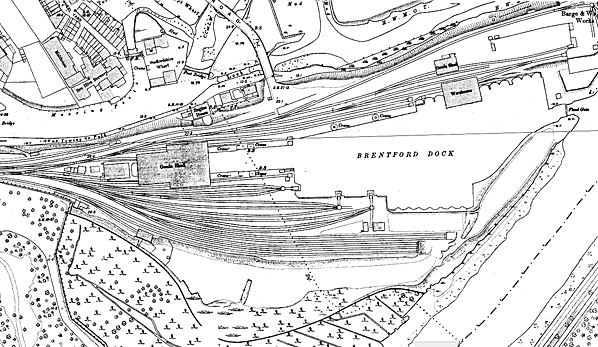
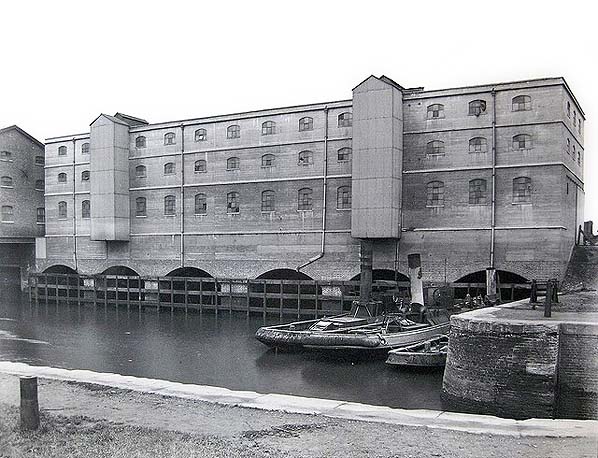
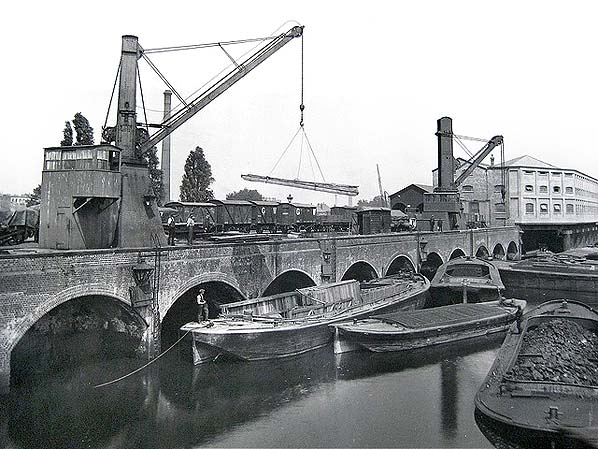
dock_old2.jpg)
dock_old10.jpg)
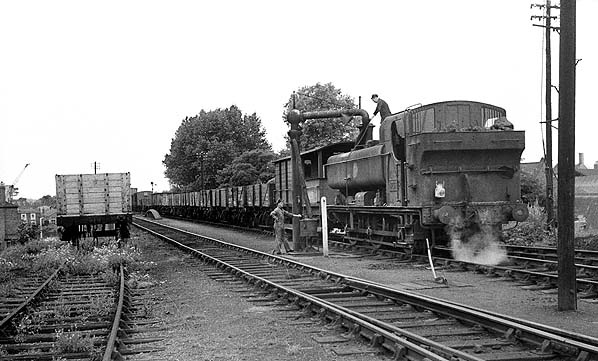
dock_old4.jpg)
dock_old7.jpg)
dock_old19.jpg)
dockol_d17.jpg)


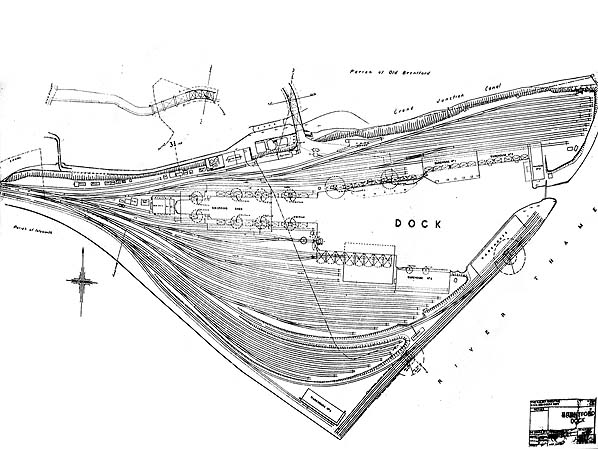
dock8.jpg)
dock10.jpg)

 Home Page
Home Page